![]()
![]()
![]()
Use LEFT and RIGHT arrow keys to navigate between flashcards;
Use UP and DOWN arrow keys to flip the card;
H to show hint;
A reads text to speech;
134 Cards in this Set
- Front
- Back
|
Chromosome
|
- composed of:
- gene (which are composed of DNA) |
|
|
Chromosome
|
- long threadlike structures with many genes arranged linearly
|
|
|
Gene
|
-located on chromosome
- Unit of heredity - Determines the particular characteristic of individuals |
|
|
DNA (deoxyribonucleic acid)
|
- complex chemical compound that forms genes
|
|
|
How are hereditary traits transmitted?
|
Through DNA
|
|
|
Germ cell
|
- any biological cell that gives rise to the gametes of an organism that reproduces sexually
- contain the DNA to be passed on from parent to offspring |
|
|
Germ cells divide by?
|
Meiosis
|
|
|
Germ cells are found in the
|
Gonads:
- testes - ovaries |
|
|
What do genes do?
|
- provides information affecting the biochemistry of cells and organisms
- affects the development, biochemical functioning and physical characteristics of organisms |
|
|
Asexual vs Sexual reproduction
Asexual |
- No Change of genetic information
- require only one parent ( one parent produces genetically identical offspring by mitosis) |
|
|
Sexual
|
- Involves change of genetic information
- Fusion of egg and sperm - May require two parents - This gives rise to offspring that have unique combination of genes ( gives genetic variation) |
|
|
Mechanisms of Asexual Reproduction
Types of asexual reproduction |
- Fission
- Budding - Fragmentation - Parthenogenesis |
|
|
Fission
|
- separation of a parent into two or more individuals of about the same size
- prokaryotes, some protists, many invertebrates |
|
|
Budding
|
- new individuals arise from outgrowths of existing ones
- e.g. hydra |
|
|
Fragmentation
|
- the breaking of the body into pieces, some or all of which develop into adults
- e.g. Some sea star, onions and tulips from bulbs |
|
|
Parthenogenesis
|
- the development of a new individuals from an unfertilized egg
- e.g some lizards, Rotifers, dandelions, worker bees |
|
|
Haploid cells (n)
|
- have one set of chromosomes in each nucleus
-e.g Human sperm and egg cells have one set of 23 chromosomes in each nucleus |
|
|
Diploid cells (2n)
|
- cells have two sets of chromosomes in their nuclei
- e.g. Humans have 46 chromosomes in EACH BODY CELL nucleus ( 2 sets of 23 chromosomes) |
|
|
Mitosis
|
- A type of cell division
- Two chromosomes replicate and both daughter cells have the same number of chromosomes as the parent - n---->n - 2n---->2n |
|
|
Function of Mitosis
|
- Reproduction of cells
- reproduction in unicellular organisms - Growth and Repair in multicellular organisms - asexual reproduction in multicellular organisms |
|
|
Meiosis
|
- A type of cell division which results in the production of haploid cells from diploid cells
- 2n>n |
|
|
Advantage of Asexual Reproduction
|
- if organisms are well suited to the environment, allows for reproduction of identical individuals
- may reproduce quickly - Offspring may start off more mature - Dense clones may reduce competition |
|
|
Disadvantage of asexual reproduction
|
- Population is unable to adapt to changes in the environment
- Could lead to extinction |
|
|
Advantage of sexual reproduction
|
- Generates variation in population
|
|
|
Disadvantage of Sexual reproduction
|
- organisms may take longer to develop
- May require more energy - finding mates - production of gonads - Producing males |
|
|
Origins of Genetic Variation Among Offspring
|
- the behavior of chromosomes during meiosis and fertilization
- Three Mechanisms: - Independent assortment of chromosomes - Crossing over - Random fertilization ( random sperm fertilizes random egg) |
|
|
The alteration of meiosis and fertilization is common to all
|
organisms that reproduce sexually
|
|
|
The three main types of sexual life cycles differ in the timing of
|
Meiosis and fertilization
|
|
|
In animals, meiosis produces...
|
- gametes
- undergo no further cell division before fertilization |
|
|
The only haploid cells in animals
|
- Gametes
|
|
|
Gametes fuse to form a
|
- diploid zygote
- zygote divides by mitosis to develop into a multicellular organism |
|
|
Alteration of generation PIC
|
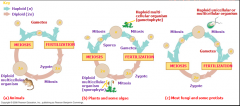
|
|
|
In plants and algae, SPOROPHYTE refers to the
|
- diploid stage in a life cycle
- that produces spores |
|
|
Spores are cells produced by
|
- meiosis
- capable of reproducing by mitosis |
|
|
Each spore grows by mitosis into a haploid organism called a
|
- gametophyte
|
|
|
A gametophyte makes haploid gametes by
|
- mitosis
|
|
|
Fertilization of gametes result in a diploid
|
- sporophyte
|
|
|
Gametes are proaduced within organs called
|
- gametangia
|
|
|
Female gametangia
|
- archegonia
- produce eggs and are site of fertilization |
|
|
Male gametangia
|
- antheridia
- sites of sperm production and release |
|
|
Gametangia in plants pic
|
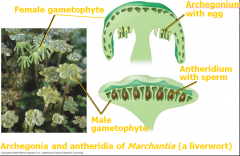
|
|
|
Life cycles of seedless plants (pic)
|

|
|
|
Bryophyte Sporophytes
Bryophyte sporophyte grow out of |
- archegonia
- are the smallest and simplest sporophyte of all extant plants |
|
|
Bryophyte sporophyte consists of a
|
- foot
- seta (stalk) - sporangium also known as capsule (discharges spores through a peristome) |
|
|
Hornworts and moss sporophytes have
|
- stomata for gas exchange ( not fully functional, bryophytes)
|
|
|
Liverworts have no
|
- stomata for gas exchange
|
|
|
Life cycle of Fern (Pic)
|
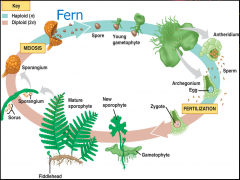
|
|
|
In contrast with bryophytes, seedless vascular plants have sporophytes as the
|
- larger generation
|
|
|
In Algae
- gametophyte is dominant - sporophyte not visible |
- multicellular haploid stage is the most visible form
- when the zygote is formed, there is no mitosis but mitosis occurs immediately to produce haploid spores - the spores then replicate by mitosis which forms the dominant muticellular haploid generation |
|
|
I Moss
|
- Gametophyte is dominant
- sporophyte is large enough to be visible |
|
|
In Ferns
|
- Gametophytes are small
- sporophytes are large and are dominant |
|
|
Gymnosperm and angiosperms
|
- the gametophyte and sporophyte stages are multicellular
- sporophyte stage is dominant |
|
|
Seeds and pollen grains are
|
- Key adaptation for life on land
|
|
|
The following are common to all seed plants
|
- Reduced gametophytes
- Heterospory - Ovules - Pollen |
|
|
Advantages of Reduced Gametophytes
|
- The gametophytes of seed plants develop within the walls of spores that are retained within tissues of the parent sporophyte
|
|
|
Ovule and production of Eggs
|
- And ovule consists of a megasporangium, megaspore and one or more protective integuments
- Gymnosperm megaspores have one integuments - Angiosperm megaspore usually have two integuments |
|
|
Pollen and Production of Sperm
|
- Microspores develop into pollen grains, which contains the male gametophyte
- Pollination is the transfer of pollen to the part of a seed plant containing the ovules - Pollen can be dispersed great distances by air or animals and eliminates the need for a film of water - If a pollen grain germinates, it gives rise to a pollen tube that discharges sperm into the female gametophyte within the ovule |
|
|
Evolutionary advantage of Seeds
|
- A seed develops from the whole ovule
- A seed is a sporophyte embryo along with its food supply packaged in a protective coat |
|
|
Advantage of Seeds over spores
|
- may remain dormant for days to years until conditions are favorable for germination
- seeds have a supply of stored food - They may be transported long distances by wind or animals |
|
|
The life cycle of a Pine
Three key features of the gymnosperm life cycle |
- Dominance of the sporophyte generation
- Development of seeds from fertilized ovules - The transfer of sperm to ovules by pollen |
|
|
The pine tree is the sporophyte and produces
|
- sporangia in male and female cones
|
|
|
Small cones produce
|
- microspores called pollen grains
- contains male gametophyte |
|
|
Larger cones contain
|
- ovules, which produce megaspores
- develop into female gametophytes |
|
|
It takes nearly
|
- 3 years from cone production to mature seed
|
|
|
Life cycle of a pine (pic)
|
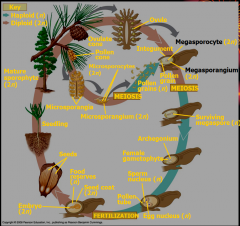
|
|
|
The Angiosperm Life Cycle
The flower of the sporophyte is composed of both |
- male and female structures
|
|
|
Male gametophytes are contained within pollen grains produced by the
|
- microsporangia of anthers
|
|
|
The female gametophyte, or embry sac, develops within an
|
- ovule
- contained within an ovary at the base of stigma |
|
|
most flowers have mechanisms to ensure cross-pollination between flowers from
|
- different plants of the same species
|
|
|
Angiosperm life cycle (double fertilization) pic
|

|
|
|
Phylum Anthophyta
|
- most widespread plants on land
- species of approx. 250 000 - Most recently evolved |
|
|
Success of phylum Anthophyta
Adaptations that prevent against desiccation |
- seed enclosed in fruit (mature ovary)
- presence of xylem vessels - Deciduous leaves - Flowers attract pollinators - Fruit ensures seed dispersal by animals |
|
|
The flower is an angiosperm structure specialized for
|
- sexual reproduction
- many species are pollinated by insects or animals, while some species are wind pollinated |
|
|
Structure of the flower
|
- sepals (encloses the flower)
- Petals ( brightly colored and attract pollinators) - Stamens (male part, produce pollen on their terminal anthers) - Carpels (female part, produces ovules) |
|
|
Carpels
|
- consists of an ovary at the base
- A style leading up to a stigma - Stigma is the opening where the pollen is recieved |
|
|
Flower structure (pic)
|
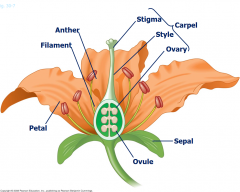
|
|
|
Earliest characteristics of flowers
|
- many parts
- mostly separate - Radially symmetrical' - "complete flower" - Superior ovary |
|
|
Recent Characteristics of flowers
|
- Few parts
- Mostly fused - bilaterally symmetrical - "incomplete" - inferior ovary |
|
|
Variation in flowering plants
Bisexual flowers |
- both stamens and carpels present
|
|
|
Unisexual flowers
|
- Stamen OR carpel present
- Monecious - both male and female flowers on the same plant - Dioecious - Only unisexual flowers (male or female) on an individual |
|
|
Fruits
|
- a fruit typically consists of a mature ovary but can also include other flower parts
- Fruits protect seeds and aid their dispersal - Mature fruits can be either fleshy or dry |
|
|
Pollination
|
- Pollen grain (multicellular haploid stage of the male gametophyte)
- Pollen grain lands on stigma - Pollen tube grows down style to the ovary - Pollen grain is composed of 2 cells: TUBE CELL and GENERATIVE CELL - Both cells have resistant coverings - Tube cell causes pollen tube to grow, its nucleus disintegrates at fertilisation - Generative cell undergoes mitotic division to form 2 sperm nuclei which migrate down pollen tube |
|
|
Pollination/ double fertilization pic
|
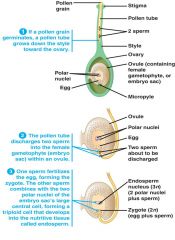
|
|
|
Double fertilization
|
- Sperm nuclei travel down pollen tube to ovary which contains multicellular female gametophyte (7 cells and 8 nuclei)
- Double fertilisation occurs - One sperm nucleus fuses with ovum in an ovule producing a zygote - The other sperm nucleus fuses with 2 other cells to produce a triploid cell which forms nutritive seed endosperm |
|
|
Variations in patterns of sexual reproduction in animals
|
- reproductive cycles related to changing seasons
- controlled by hormones and environmental cues - temperature is often and important cue in reproduction, therefore, climate change can decrease reproductive success |
|
|
Estrous cycles are characteristics of most mamals
|
- the endomentrium is reabsorbed by the uterus
- Sexual receptivity is limited to a "heat" period - The length and frequency of estrus cycle vary from species to species |
|
|
hermaphrodites
|
- Functions as both male and female
|
|
|
Examples of hermaphrodites
|
- Sponges- most of them are sequencial hermaphrodites, functioning first as one sex and then the other
- Earthworms - Flatworms - Some mollusks - Fish (rarely) |
|
|
Hermaphroditism is most common in
|
- sessile species and some worms
|
|
|
Sequencial Hermaphroditism
|
- their sex changes somewhere within the lifetime of individual
- usually occurs as the organism grows larger |
|
|
Types of Sequencial Hermaphrodites
|
- Protandrous Species
- Protogynous species |
|
|
Protandrous species
|
- Change from male to female
- large females have the capacity to carry more eggs -e.g damselfish |
|
|
Protogynous Species
|
- change from female to male
- larger body size is then associated with aggressive behaviour - most often haremic fish - form monoandric harems, comprising of 1 male and numerous females for life. the dominant female of the harem will undergo sex change from female to male |
|
|
Protandrous species are rarer than
|
- protogynous
|
|
|
Carribean bluehead wrasse
|
- all individuals are born female
- the oldest and largest become males |
|
|
Earthworms are hermaphroditic but cross fertilize because
|
- male and female organs are in different segments
- increased genetic variation |
|
|
External Fertilization
|
- Requires and aquatic habitat
- males fertilize eggs after they are released from females - Males also search out egg clutches and fertilize the eggs |
|
|
Problems with external fertilization
|
- Timing of release of and sperm
- Dilution of egg and sperm - Predation - Little or no parental care |
|
|
Internal Fertilization
|
- An adaption to terrestrial life
- Sperm are motile and must have a fluid environment for fertilization - Timing is important -mature eggs must be available, hormones affect timing of egg production |
|
|
Ensuring the survival of offsprings
|
- internal fertilization= fewer gametes but higher survival of a higher fraction of zygotes
- internal fertilization provides mechanism to protect embryos and parental care of young - some embryos of terrestrial animals develop into eggs which provides protection - some animals retain the embryo, which develops inside the female - In many animals, parental care helps ensure survival of offsprings |
|
|
Oviparous
|
- Eggs are laid and embryonic development occurs outisde the mother's body
- most indertebrates - Fish, Birds, Amphibians and reptiles, some mammals (platypus) |
|
|
Ovoviviparous
|
- Eggs develop and hatch within the mother's body, but the mother does not provide nutrition during development
- Clams, oysters, several fish species, lizards, some snakes |
|
|
Viviparous
|
- Fertilized egg stays within the mother's body, the mother nourishes it until the young are born
- Mammals, some sharks, a few insects, some scorpions, some earthworms |
|
|
Most insects have
|
- separate sexes
- with complex reproductive systems |
|
|
In many insects, the female has a _______, in which sperm is stored during copulation.
|
- Spermatheca
|
|
|
Insect reproductive system pic
|

|
|
|
A cloaca
|
- is a common opening between the external environment and the digestive, excretory, and reproductive system
- all in one opening :D - common in nonmammalian vertebrates - mammals usually have seprarate opening to the digestive tract |
|
|
Male Reproductive Organ
|

|
|
|
Male reproductive organ side view
|

|
|
|
Female Reproductive Organ
|
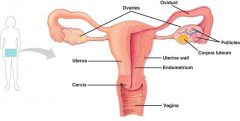
|
|
|
Female Reproductive Organ side view
|
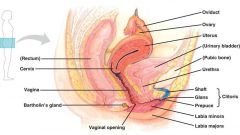
|
|
|
Primary sex characteristics MALES
|
- Testes
- Epididymis - Vas Deferens - Penis |
|
|
Primary sex characteristics FEMALES
|
- Ovaries
- Oviduct - Vagina - Accessory glands |
|
|
Secondary sex characteristics MALES
|
- Facial hair
- Deeper voice |
|
|
Secondary sex characteristics FEMALES
|
- Voice
- Hair - Breasts |
|
|
What is Sexual selection?
|
- The ability to acquire mates
- Form of natural selection |
|
|
Two types of sexual selection
|
- Intrasexual selection
- Intersexual selection |
|
|
Intrasexual selection
|
- Where the competition is among one sex
- usually in males - e.g. antlers in deers |
|
|
Intersexual selection
|
- where the choice of mate is based on characteristics in the other sex
- choice is often made by females - e.g. peacock feather display |
|
|
Mating Behaviour and mate choice
|
- Mating behaviour includes seeking or attracting mates, choosing among potential mates, competing for mates, and caring for offspring
- Mating relationship between males and females vary greatly from species to species - |
|
|
Mating behaviour and mate choice
types of mating behaviour |
- Promiscuous: no strong pair-bonds or lasting relationship
- Monogamous: one male mates with one female |
|
|
Mating behaviour and mate choice
Males and females with monogamous mating systems have similar |
- external morphologies
|
|
|
Mating behaviour and mate choice
In polygamous relationships, and individual of one sex mates with |
- individual of one sex mates with several of the opposite sex
- dimorphic: males and females have different external morphologies - can be either Polygynous or Polyandrous |
|
|
In Polygynous relationship
|
- one male mates with many females
- the males are usually more showy and larger than the females |
|
|
In Polyandrous relationship
|
- one female mates with many males
- females are often more showy than males |
|
|
Mating system and parental care
Examples of parental care |
- Bird species where chicks need a continuous supply of food: male maximizes his reproductive success by staying with his mate and caring for his chicks (monogamy)
- Bird species where chicks are soon able to feed and care for themselves: male maximizes his reproductive success by seeking additional mates (polygyny) |
|
|
Certainty of paternity influences
|
- parental care and mating behaviour
|
|
|
Paternal certainty depends on
|
- Mating behaviour
|
|
|
Paternal certainty is relatively low in species with
|
- internal fertilization because mating and birth are separated over time
|
|
|
Certainty of paternity is much higher when
|
- egg laying and mating occur together
- external fertilization |
|
|
In species with external fertilization, parental care is likely to be done by the
|
- male
|
|
|
Mate choices by Females
|
- Female choice is a type of intersexual competition
- females can choose males with specific behaviours or features of anatomy - e.g. female stalk eyed flies choose males with relatively long eyestalks |
|
|
Male Competition for Mates
|
- male competition for mates is a source of intrasexual selection that can reduce variation among males
- such competition may involve agonistic behaviour, an often ritualized contest that determines which competitor gains access to a resource |
|
|
Life history aspects important to Reproductive success
|
Age at first reproduction
- Brood size - Number of broods per lifetime - Inter brood interval - Reproductive cost of young |

